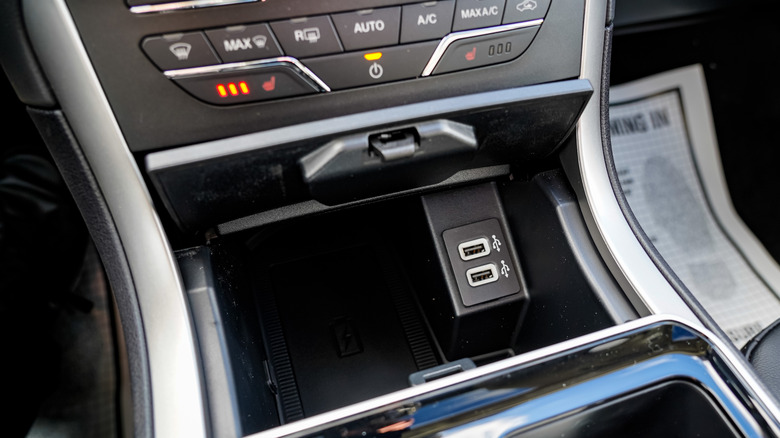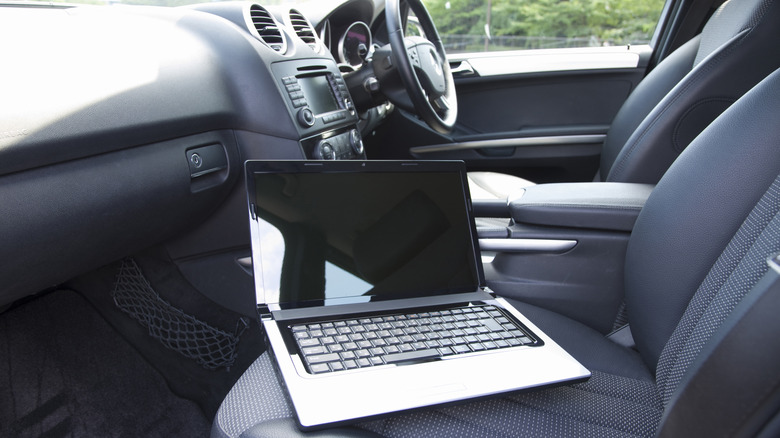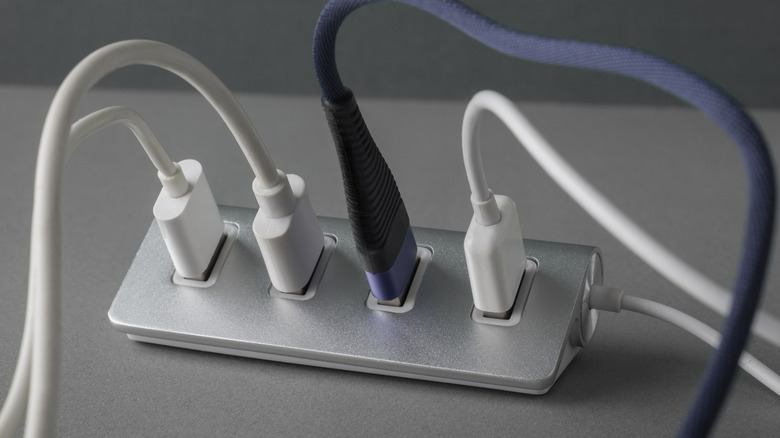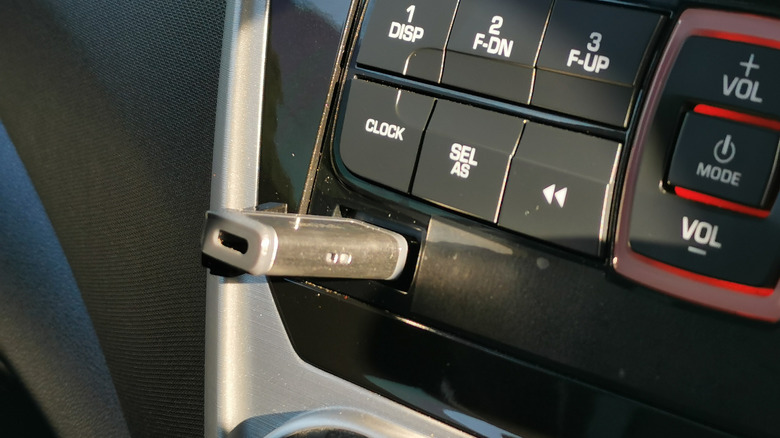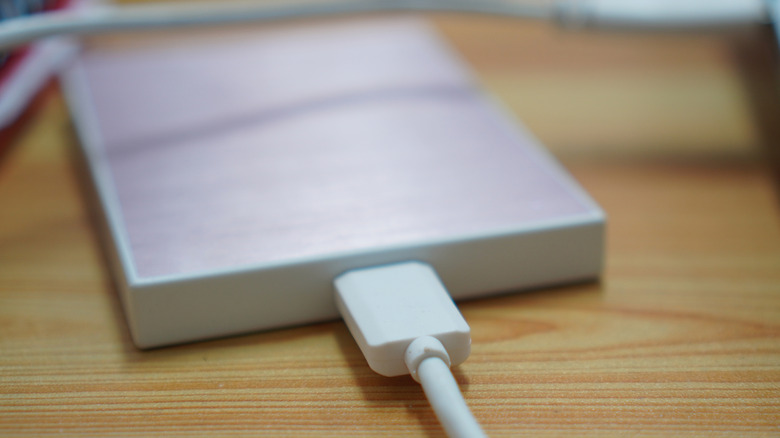Never Plug These 4 Things Into Your Car's USB Ports
If you're a car enthusiast, you might have noticed how USB ports have become a universal feature on newer cars, and that there are several ways to use vehicle USB ports. Now, given that most USB ports on cars look exactly like the ones on your laptops and computers, there's a misconception that whatever plugs into your computer would also work on a car. This is not true: All USB ports are not created equal, and misunderstanding their limits on cars can lead to frustration, privacy risks, or even hardware damage.
Traditionally, cars featured infotainment systems with low-power USB ports that were designed to simply read and access data from connected devices. While they could supply power to connected devices, the output was way too low for even smartphones to be charged at a decent pace. If you have an older car, you may have noticed how long it really takes for it to charge your phone with the standard car USB port. On more recent cars, this issue has been largely fixed thanks to support for newer, faster charging standards and the prevalence of USB-C.
Nevertheless, while car USB ports have improved, it is always best to check the compatibility of your USB device and your vehicle before plugging it in. Even with supported devices such as smartphones and thumb drives, you should exercise caution before plugging them into car USB ports, especially if you are using a rented vehicle. There is no blanket ban on devices that should not be connected to a car's USB port, but there are several devices to either be cautious of, or otherwise won't do anything when plugged in; including laptops, gaming consoles, USB hubs, and external hard drives.
High-power devices like laptops and gaming consoles
Plugging in a device that demands a large amount of power from a car's USB ports is generally not a good idea. These devices typically include laptops, portable gaming consoles, and some large tablets. These devices usually require 30 to 100 watts of power to charge, and given that old USB ports max out at 2.5–4.5 watts, charging these devices using a car USB port will take an atrociously long time, and in some instances, could also lead to blown fuses.
That being said, the auto industry is evolving, and many automakers now integrate USB-C PD and Qualcomm QC ports rated for much higher power delivery. Some EVs, like the Hyundai Ioniq 5 and Tesla Model X, feature 27W ports strong enough to charge laptops. Compatibility matters, too: If your phone doesn't support PD/QC, it defaults to safer, much slower charging speeds. The safest approach before plugging in a non-standard accessory to your car's USB port is to look for your car's manual for wattage ratings and reserve high-draw devices for the 12-volt outlet using USB hubs and adapters.
If charging is your primary goal when connecting gadgets to your car, the best approach is to invest in an add-on USB or USB-C hub that draws power from the car's electrical system. These hubs can provide reliable, faster charging speeds compared to dedicated USB ports, some even reaching 100W. To summarize things, while the "slow charging" issue is fading in new cars, even modern-day infotainment USB ports are not replacements for wall sockets.
Daisy-chained USB hubs
On laptops and computers, it's not uncommon for people to connect a USB hub to a single USB port, and then connect multiple devices to it. Doing the same thing on cars may seem clever, but what you are essentially doing here is overloading a system designed for single-device use. Some cars even throw an error message if it detects that a USB hub is connected to it, and it is drawing more power than the car USB port can provide.
The problem with daisy-chained hubs is that the total demand from connected devices can easily exceed whatever the port is actually rated to provide. Imagine a single phone trying to draw ~1A while another device attempts to charge from the same port through a hub: the cumulative load may surpass the fuse's protection threshold. In these conditions, the best possible outcome is an atrociously slow charging device, while the worst is a possibly blown fuse. The latter, however, not only ends up disabling a working USB port, but may have a cascading effect on other electronic parts of the car.
The risk of this happening is higher with low-quality hubs or fast-charging knockoffs; many of which lack voltage regulation, creating dangerous spikes. Automakers and regulatory agencies warn against such setups in owner's manuals. Therefore, the safer (and faster) charging route is to use a multi-port charger designed for the 12-volt outlet, where wattage can be properly distributed, and surge protection is built in as a safety net. Even on these usually resilient 12V outlets, complaints about blown fuses aren't uncommon.
Unknown USB drives
USB ports on computers have long been a common entry point for malware. While car infotainment systems are relatively low on the vulnerability list in terms of USB-port-induced infections, there is no denying that a threat is always around the corner. Car infotainment systems are vulnerable to malware injection attacks, and the FCC has issued warnings centered on this phenomenon, colloquially known as "juice jacking." In this phenomenon, malware is loaded onto devices through compromised USB ports, malware infected pen drives, and cables.
Although juice jacking poses a greater threat at airports and areas with numerous public charging stations, cars are equally at risk, given that infotainment systems run on operating systems that can be exploited by malicious firmware. Security researchers have demonstrated that infotainment systems can store traces of connected devices, including playlists, contacts, and even call histories. There have also been instances wherein data belonging to prior renters was accessible to others, long after their phones were disconnected from the system.
The rule of thumb is simple: Don't plug unknown drives into your car. If you need media, use Bluetooth streaming or a dedicated, personal USB stick. Treat your car's USB port like a public computer terminal. If you wouldn't trust it in your laptop, don't use it in your car.
External hard drives and storage devices
It's not common for people to plug in devices like hard drives and SSDs into a car's USB port. Still, some manufacturers, including Honda and Kia, felt the need to explicitly mention this in user manuals. Kia, in particular, states in one of its user manuals that hard disk drives may not be recognized after they're plugged into the vehicle's USB ports. That being said, other car manufacturers are quite ambiguous about it. Given that most people wouldn't typically attempt it on modern-day cars, it is currently not a major concern among automakers.
Interestingly, automakers do not explicitly state the reasons why they do not want hard drives anywhere near car USB ports. However, given that hard drives also require a significant amount of power to start up, the primary reason could be the same thing discussed earlier: the lack of enough electrical power to ensure that the hard disk performs as intended.
Without enough electrical current, drives can repeatedly disconnect, which can corrupt data. This is besides the fact that a car's dashboard area is a hostile environment for hard drives. Constant vibrations and a host of temperature variations could prove fatal to drives over time. Some car infotainment systems struggle with newer, more advanced file systems, preventing data from these devices from being accessed. If all these risks weren't enough, plugging in a hard disk carries the same risks as plugging in a standard USB drive. Exercising caution is always a good idea.
